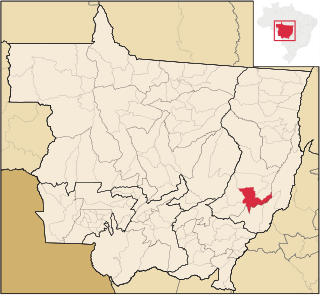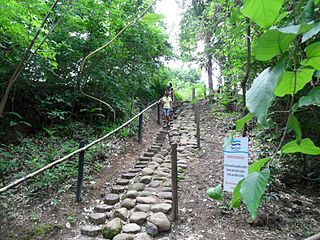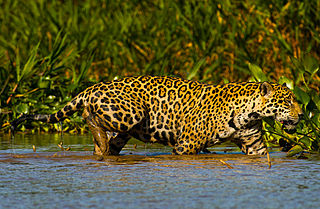Location
The Serra Azul State Park is in the municipality of Barra do Garças in the east of Mato Grosso. It has an area of 11,002.4 hectares (27,188 acres). The park contains a landmark for the geodetic center of Brazil.
The park is in the Guimarães plateau, bounded to the north by the Paranatinga depression, to the east by the Araguaia depression and to the northeast by the Parecis plateau. Altitudes range from 350 metres (1,150 ft) at the park entrance to 730 metres (2,400 ft) at the highest points. The terrain is rugged, including flatter areas and steep escarpments with slopes of more than 45º. The park is on the bank of the Araguaia River, and is in the Araguaia-Tocantins basin. The mountains give rise to many streams that feed the Araguaia River or the Rio das Mortes.
History
The Serra Azul State Park was created by state law 6.539 of 31 May 1994. It is administered by the Secretary of State for the Environment (Sema). On 10 August 2015 governor Pedro Taques signed an agreement with the municipality of Barra do Garças for investment in the park's infrastructure and improved staffing.
A fire burned 80% of the vegetation in August–September 2014 and the park was closed. It reopened for paragliding by members of the Free Flying Association in December 2015. Schools and universities were also allowed monitored access to the park subject to advanced authorization. SEMA said in 2015 they planned to gradually open new areas for visitors, who average 2,500 per month, to allow better security and conservation of local biodiversity.
Environment
Soils are mainly litholic, from sandstone formations, but flat areas have yellow latosol. The Köppen climate classification is Aw, with two well-defined seasons. The dry season is from April to September, and the rainy season from October to March. Fires sometimes break out in the dry season. There were fires in 2002, 2005, 2007, and 2012. The fire in 2007 affected 80% of the park. There are small roads around some areas, remains of old farm roads from before the land was expropriated, which serve as firebreaks.
The park is in the cerrado biome. Vegetation includes gallery forests, semi-deciduous forests, typical cerrado and rocky cerrado. About 800 species of vascular plants have been identified, and 180 species of birds, but the flora and fauna had not been subject to thorough inventories as of 2015. The Astyanax xavante is a fish that is endemic to the Córrego Avoadeira, the largest stream in the park. The Bororó people, who used to live in the area, called the park Kieguereiral ("Place of Birds") due to the great diversity of birds.

Mato Grosso is one of the states of Brazil, the third largest by area, located in the Central-West region. The state has 1.66% of the Brazilian population and is responsible for 1.9% of the Brazilian GDP.

The Araguaia River is one of the major rivers of Brazil, and a tributary of the Tocantins River.

Barra do Garças is a city with a population of 61,135 located in the Brazilian state of Mato Grosso, around 550 km (340 mi) from the capital city of Cuiabá. It was founded on 13 June 1924, but it became politically independent on the 15th of September 1948. Nowadays, Barra do Garças is the 8th biggest city in Mato Grosso. The city is situated on the border between the Mato Grosso and Goiás states and due to this the area is considered a geodesic center.

The Chapada dos Guimarães National Park is a national park in the state of Mato Grosso, Brazil. It is a region of rugged terrain with dramatic cliffs and waterfalls, and contains the geographical centre of the continent.

The Emas National Park is a national park and a UNESCO World Heritage Site in the states of Goiás and Mato Grosso do Sul in Brazil.

Nobres is a city in the state of Mato Grosso, Brazil. It is located approximately 140 kilometers from Cuiabá on the south slopes of the Serra Azul.

Serra da Bodoquena National Park is a national park in the state of Mato Grosso do Sul, Brazil.

Nova Xavantina is a municipality in the state of Mato Grosso in the Central-West Region of Brazil.

The Águas Quentes State Park is a state park in the state of Mato Grosso, Brazil

The Encontro das Águas State Park is a state park in the state of Mato Grosso, Brazil. It covers an area of the pantanal rich in watercourses.

The Gruta da Lagoa Azul State Park is a state park in the state of Mato Grosso, Brazil. Its primary attraction is a limestone cave with a pool of blue water and unusual cave formations. These have suffered from vandalism, causing the cave to be closed until measures to protect it could be implemented.
The Serra de Santa Bárbara State Park is a state park in the state of Mato Grosso, Brazil. It preserves a unique environment where the Amazon rainforest, pantanal and cerrado meet, and holds many endemic or endangered species.
The Mirador State Park is a state park in the state of Maranhão, Brazil. It protects the headwaters of an important source of water for communities in the state, including the state capital. Its own protection from illegal logging, slash-and-burning, grazing and hunting is underfunded.

The Cristalino State Park is a state park in the state of Mato Grosso, Brazil.

The Matas do Segredo State Park is an urban state park in the state of Mato Grosso do Sul, Brazil. It protects an area of cerrado forest.

The Araguaia State Park is a state park in the state of Mato Grosso, Brazil. It protects an area of annually flooded cerrado in the transition to Amazon rainforest, and is rich in biodiversity.

The Serra Ricardo Franco State Park is a state park in the state of Mato Grosso, Brazil. It protects the edge of a plateau on the border with Bolivia in the region of transition from cerrado to Amazon rainforest. The park has been poorly protected and is badly degraded in areas by deforestation and conversion to pasturage. It is threatened by illegal squatters, hunting and burning.
The Nascentes do Rio Taquari State Park is a state park in the state of Mato Grosso do Sul, Brazil. It protects the headwaters of the Taquari River in an area in the transition between the cerrado and pantanal biomes.

The Serra dos Martírios/Andorinhas State Park is a state park in the state of Pará, Brazil. It protects a mountainous region of forests in the transition between the Amazon rainforest and cerrado biomes, beside the Araguaia River. The park contains caves that hold ancient rock carvings and paintings. Some of the caves are endangered by tourists or by local people who camp in them while they perform the annual Festival of the Divine Holy Spirit.

The Serra do Cabral State Park is a state park in the state of Minas Gerais, Brazil.
This page is based on this
Wikipedia article Text is available under the
CC BY-SA 4.0 license; additional terms may apply.
Images, videos and audio are available under their respective licenses.


















